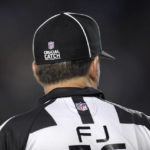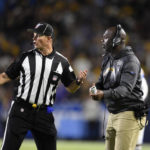Tim Benz: Did refs in Steelers’ game open replay wormhole to fix call?


Share this post:
Because of all the bad calls in the “Monday Night Football” game between the Detroit Lions and Green Bay Packers, NFL officiating is top of mind this week.
So it got me flashing back to Sunday night’s confusing fair-catch moment between Los Angeles Chargers punt returner Desmond King II and Steelers special teamer Justin Layne.
It felt like a moment where the officials may have skirted the rules of replay to get a missed call right.
That certainly would’ve been nice Monday. It’s not a bad idea — if not for the fact it’s completely illegal.
I’ll refresh your memory
Late in the third quarter, King II called for a fair catch deep in his own territory. At first, it appeared he fumbled a Jordan Berry punt back to the Steelers at his own 8-yard line. That was the call on the field.
But Layne appeared to violate King’s ability to complete the fair catch. Watching the television replays, it sure looked like Layne made contact with King, the ball or both.
If the officials had decided to go through with fumble call and had awarded the Steelers possession, that would’ve been huge, given that the spot was deep in the L.A. red zone.
If they decided to give the Chargers 15 penalty yards because Layne interfered, that would’ve definitely helped Los Angeles’ efforts.
Judging from the replay, the crew eventually got the call right. They let the Chargers keep the ball, but Layne didn’t get flagged.
I’m making that assumption based on an inquiry I made to Terry McAuley on Twitter. He’s a former NFL official who now works the NBC’s “Sunday Night Football” broadcasts as a rules analyst. Here’s his reply.
It was an unusual play and the crew huddled right after the announcement to discuss. It likely took the input of multiple officials to determine there was a valid fair catch signal, the receiver muffed the ball, and then the ball was touched by the Pit player.
— Terry McAulay (@SNFRules) October 14, 2019
It was very close as to whether the receiver bobbled first or the ball was touched by Pit first. If bobbled, then no yardage penalty. If touched without bobble then a 15 yard penalty. That would likely have been part of the discussion.
— Terry McAulay (@SNFRules) October 14, 2019
Ok. I’m still not clear why that differentiation in the rule exists. If Layne’s interference on the catch caused the bobble in the first place because he was too close, shouldn’t that be a penalty against the Steelers if the Chargers got to keep the ball?
But, whatever.
More material to the point is, mechanically, how did that play get reversed?
Even though turnovers get reviewed by replay, you can’t review that infraction by Layne when it didn’t get called in the first place.
Unlike pass interference. Or offsides in hockey. Or a flagrant call in basketball.
It feels like the crew split the difference to get the proper result on the field and avoid getting egg on its face. They probably just guessed because they weren’t allowed to go to replay and they couldn’t figure out what happened for sure.
So they hashed it out on the field discussing among themselves. Or…
1. They somehow got word from New York that they screwed up and fixed it.
2. They realized they screwed up by looking at the big screen.
I asked McAuley about that layer of the onion, too.
Yes…that is a reasonable question to ask given the communication system in place. It really should only be used for administration purposes such as timing adjustments, spot of fouls, spots where the runner is down on change of possessions, etc.
— Terry McAulay (@SNFRules) October 14, 2019
If you look at the ground level shot, the BJ who is responsible for the play is behind the receiver and could never have seen the touch so he would have to get help from someone else…hopefully another onfield official.
— Terry McAulay (@SNFRules) October 14, 2019
Former official Gene Steratore, now with CBS, was on WDVE Tuesday morning, and I asked him how often that practice takes place.
“I never communicated with the NFL command center (on a non-reviewable play),” Steratore told me.
He insisted his crew “never got together to pretend like we were talking while (the officials in the command center) were looking at a replay to come to the final answer.”
However, Steratore admitted that back in the days before the on-field refs communicated with the command center, he “may have” huddled with a few of the officials and encouraged another member of the crew out of the camera shot to peek at the big screen and relay to group what he saw.
But Steratore went so far as to say he would’ve preferred to get the call wrong than bend the rules like that.
What went down in L.A. on Sunday night? How did those officials go about correcting that incredibly difficult, bang-bang call without any visual aid?
We’ll likely never know. And to reiterate, in the end, the call was right (I guess), and the game wasn’t remarkably influenced.
But in an era where the procedure of how to properly activate instant replay — and the legitimacy of what can and can’t be challenged by replay — is as important as the execution of the call itself, that relatively innocuous incident needs to be remembered.
Because as it stands right now, the NFL is allowed to engage replay on nebulous, interpretive non-pass interference calls where flags can be thrown after the fact. But it isn’t allowed to be engaged on a much more clear-cut — and potentially more important — violation like the one involving Layne and King II.
And that’s a tremendous inconsistency.



